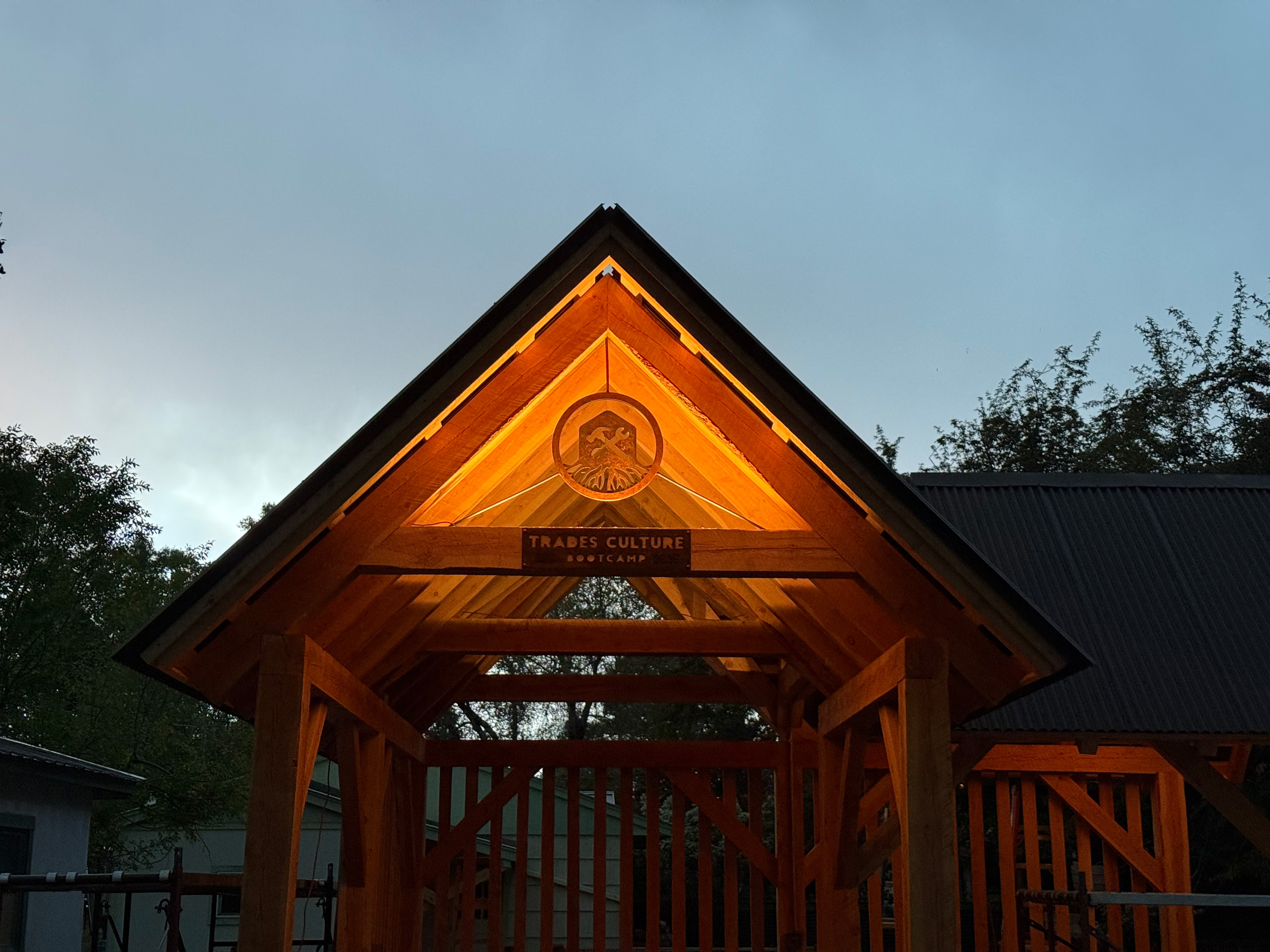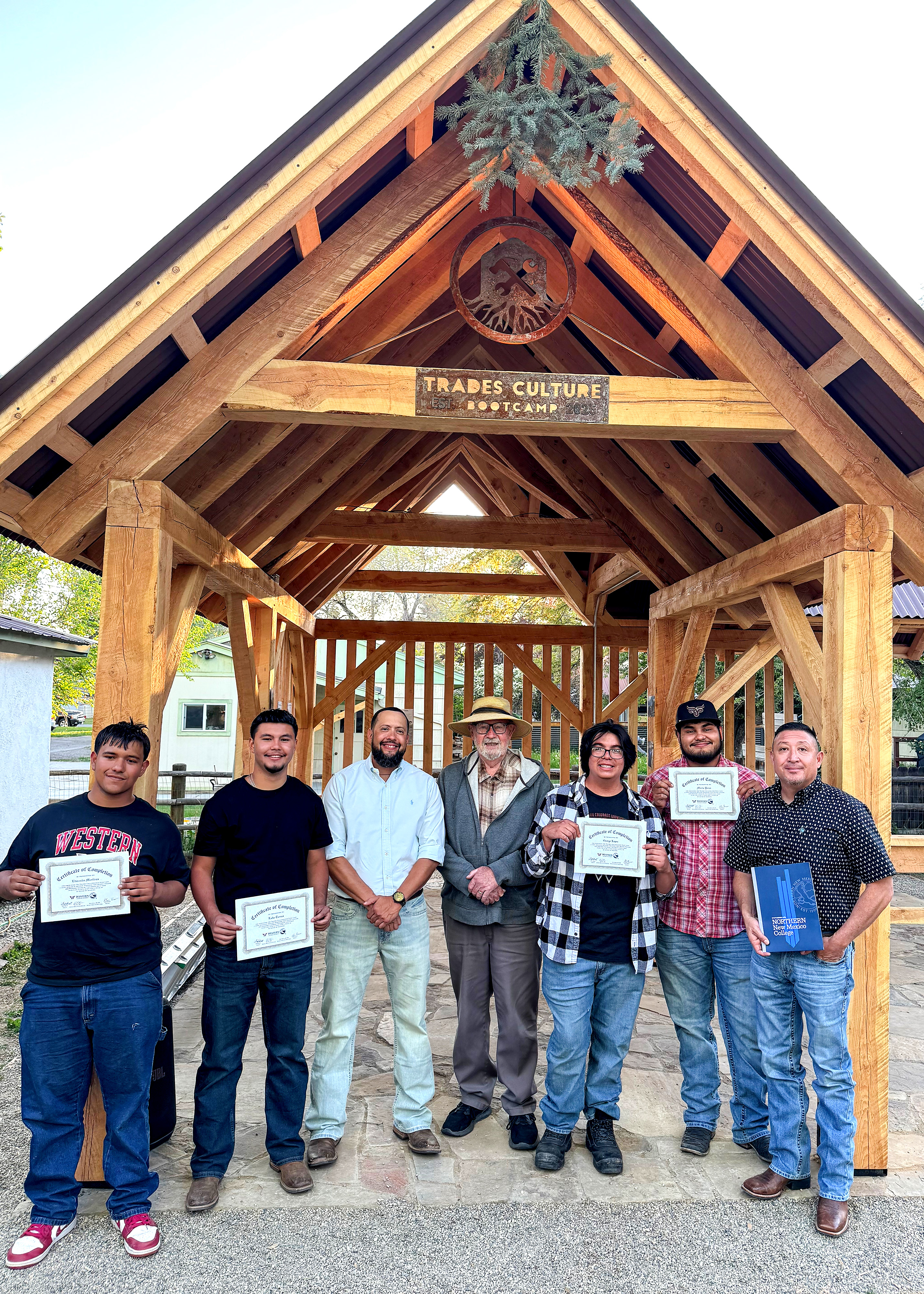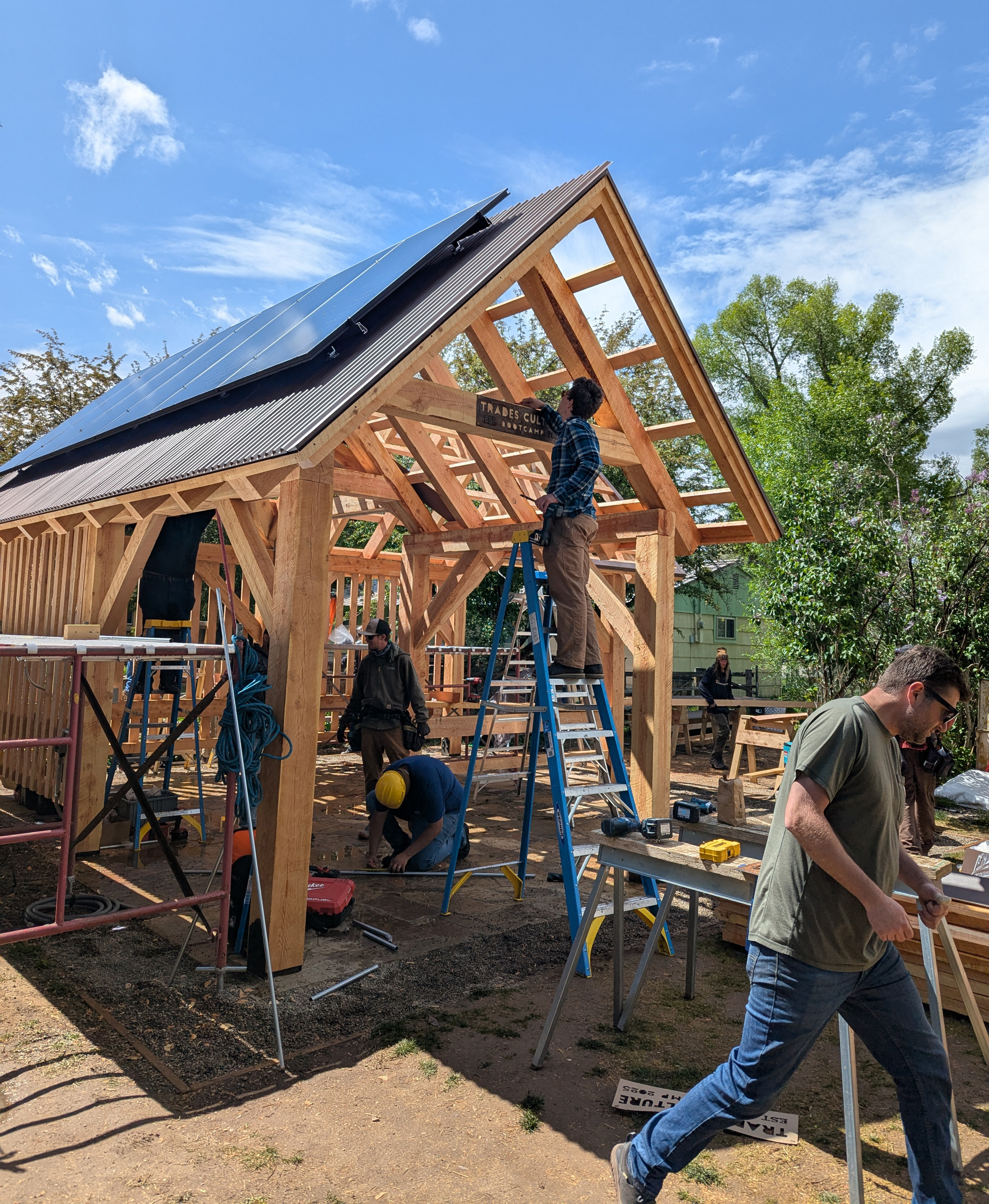
Search
Quicklinks

By Arin McKenna
July 31, 2025
Northern students get hands on training building a solar powered gazebo
Four Northern New Mexico College (NNMC) students got the opportunity to practice the skills they have been learning in Northern’s Electrical Technology program as well as new construction techniques at a Trades Culture Bootcamp crafted specifically for NNMC trades students. Western Colorado University (WCU) hosted Luka Torrez, George Lopez, Mario Perez and Edwardo Martinez for the inaugural trades camp in Gunnison, Colo., in June 2025, where they helped build a solar powered gazebo that will let WCU students study outdoors in comfort.
 “The experience for the students was amazing. The structure that was built was amazing,
especially being built in four days,” said Joe Padilla, chair of Northern’s Technical
Trades Department. “The timber framers and the people they were working with were
really impressed with our students, both their intelligence and their work ethic.”
“The experience for the students was amazing. The structure that was built was amazing,
especially being built in four days,” said Joe Padilla, chair of Northern’s Technical
Trades Department. “The timber framers and the people they were working with were
really impressed with our students, both their intelligence and their work ethic.”
Ralph E. (Butch) Clark, III, who has been a generous donor to Northern’s Technical Trades Department for several years, conceptualized and financed the bootcamp. NNMC and WCU collaborated with Clark and his attorney William Edwards on both the planning and execution of the bootcamp. Hearth Design Build Owner Cillian Liam Barrett and a Gunnison solar company, Nunatek Energy, participated in the project. The structure, which was erected on Clark’s property, will be donated to WCU. Clark is hoping that this and future bootcamps lead to increased trades education in that region.
Students were selected to participate based on their grades, their performance in class and their behavior and attitudes. Both Padilla and Electrical Instructor Marvin Romero, who also participated in the bootcamp, based much of their decision on observing students in their classrooms. The Dean’s List came out as the group was leaving for Colorado, and all four students were on the list.
The trip to Gunnison was made in the trades van that Clark had purchased for the trades program.
“We loaded it with tools and we took it to the worksite, and that was kind of cool, being able to actually use this trades van that Butch purchased for us to go out and work in his hometown on a project that he was funding,” said Padilla said.
The camp was designed so the students would learn about the techniques involved in each day’s construction objectives in the morning, then apply that knowledge to their work on the structure in the afternoon.
“We got the theory of it, and then we got to actually do it,” said Luka Torrez, an electrical technology student starting his second year. “We were guided by the professionals. They would tell us what to do and they would show us how to do it. We got to learn what they were doing and why they were doing it that certain way.”
The project started at the Paul M. Rady School of Computer Science and Engineering, where the students prototyped and designed decorative plaques for the structure, one reading “Trades Culture Bootcamp” and the other depicting a crossed hammer and wrench with roots radiating out below them. To create the plaques, they learned to use plasma cutters and a CNC (Computer Numerical Control) machine, which uses a computer program to control machine tools to fabricate objects.
 The students were introduced to timber framing and assisted with building the structure
itself and installing a corrugated tin roof. The final days were devoted to installing
the solar panels and constructing the electrical infrastructure.
The students were introduced to timber framing and assisted with building the structure
itself and installing a corrugated tin roof. The final days were devoted to installing
the solar panels and constructing the electrical infrastructure.
Each day brought new experiences and learning opportunities, as well as ways to apply their classroom learning to a construction project. They were able to observe how precisely a professional timber framer measured and cut the large beams. The solar expert shared knowledge about how solar panels are chosen based on their capacity and their ability to meet the demands of various environments and how placement affects the efficiency of the panels. The electrician explained why he wanted the placement of outlets and lighting a certain way, to provide the best experience for students using the structure at any time of day.
“Just being able to apply some of the code that we’ve gone over in our class, like for the solar part of the job, was really helpful because it actually gave a better visual than a book can give,” Romero said.
The students also got to experience the demands of being on an actual jobsite, getting a taste of what to expect in the career they’ve chosen. They had to suit up in safety gear, work with harnesses on a roof, deal with machinery and work in uncomfortable positions for several hours. They had to work around a lot of rain but still completed the project on time.
“That was the best part of the experience, because that’s something we preach to them as they become trades students. Depending on the trade that you pick, you’re going to have to work in the elements. You have to deal with the heat. You have to deal with the cold. And it’s hard work,” Padilla said. “Being a good tradesperson, a good craftsman, doing top notch work is something we instill in our students, because their name’s attached to whatever they’re working on.”
“Especially for the electrical trades, people come into it thinking this is the easiest of the trades. But it’s not like that at all. I thought, if this wasn’t the right field for these guys, they would know after this,” Romero said. “Also, it was good to be able to actually troubleshoot and learn how we build, physically, because that’s what’s difficult. It’s one thing for it to be on paper as a plan, but it’s a different matter when you’re actually dealing with the stuff.”
Padilla and Romero were both proud of the way the students threw themselves into the work and by the professional crew’s confidence in their work. Padilla said, “They were all very impressed with our students.”
“Our students had to work as a team, work safely and take direction with a good attitude,” Romeros said. “The students did a great job. They willingly did everything asked of them and then some. Their attitudes were really great, which I thought was awesome because they represented our college the way we wanted them to. They made me look good. They made the college look good.”
The impacts of the bootcamp were far ranging. Northern students were able to experience another campus, stay in the dormitories and interact with WCU students and faculty. The students came away with a better understanding of all the elements involved in construction, not just the electrical skills of their chosen discipline.
“Working with the different crews out there gave them an opportunity to be part of another person’s world. We were able to go out there and soak in all the knowledge that they had, the way they operated as a crew,” Romero said. “It was a good collaboration, mixing different cultures, seeing a different culture than the culture that they’re used to. When we first got there, everybody was kind of like feeling each other out, but by midweek we made good friends with the crews there and had a really good rapport.”
That interaction with a whole new group of people was one of the highlights for Torrez.
“I got to learn and to meet new people and make new friends and get my name out there, not to be popularly known, but to have them say, ‘Oh, Luka Torrez, he’s a good man. He’s hard working, he’s trustworthy and he’s someone you can rely on,’” Torrez said. “And I felt like I got a little closer to my fellow classmates. We knew each other pretty well from the class, but I felt when we actually talked with each other and spent some time together we created a bond that will last forever.”
The camp ended with some special experiences for both staff and students.
One was a Topping Out Ceremony, a tradition in the timber framing community. A spruce branch was attached to the highest point of the structure to pay homage to the trees used in the structure and to the many hands that built it. The ceremony also symbolizes the establishment of the structure’s roots, which will nourish a long and prosperous life.
The students spent their final day with a whitewater rafting trip followed by a barbeque dinner in the new gazebo. They were presented with Certificates of Completion for their week in the bootcamp and got to thank Clark personally. Western Colorado University, President Brad Baca attended the event.
After seeing the finished gazebo, Torrez said, “It felt great knowing I had something to do with it, that I participated in something that’s going to stand there for 100 years plus, and people will be able to use it. It just feels like I contributed to society, to the world. It felt good. It has a warm place in my heart.”
Northern and WCU are already talking about what they might do differently for next year’s bootcamp. Padilla anticipates planning for that will begin soon. ♦
The Spruce Ceremony
Today we mark a moment of deep tradition and quiet celebration.
With this spruce branch raised to the highest point of the frame, We honor a craft
that reaches back through centuries.
This branch is more than decoration—
It is a symbol of life, resilience, and enduring connection.
It honors the trees from which this timber came and gives thanks to the forest for
its gift.
It blesses the hands that shaped this frame, The minds that planned it,
And the hearts that will one day call it home.
In lifting this branch to the apex, we mark the frame's completion—
A moment of strength, of balance, of promise.
The bones of the building now stand proud against the sky.
May this frame endure the seasons with grace.
May the space it creates be filled with warmth, laughter, and peace.
And may we never forget the living roots of our craft.
To the frame.
To the forest.
To the future.